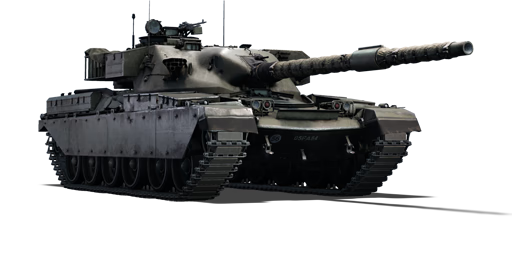

Ground Vehicles
Chieftain Mk 3
VI
Rank
AB
8.7
RB
8.7
SB
8.7
Battle rating
Great Britain
Research country
Medium tank
Main role
135,000

Research
380,000

Purchase
General information
The Chieftain Mk 3 is a British medium tank. It was introduced in Update 1.57 "Battle March" and established the series of end-game ground vehicle for the British tree. The Chieftain imposes a formidable force of reckoning on the battlefield with its heavily sloped armour and powerful 120 mm armament.
The Chieftain series maintains the traditional UK lower front plate weak spot and strong turret armour of the Centurion series of tanks while increasing the firepower. Top speed increases from the Centurion line, but overall mobility is comparably worse.
Camouflages
Survivability and armour
Armour
front / side / back
Hull
86 / 38 / 25 mm
Turret
280 / 86 / 45 mm
Visibility
88 %
Crew
4 persons
Support systems
Mobility
Max speed
Forward
4954 km/h
Backward
1113 km/h
Power-to-weight ratio
11.810.822.518.9 hp/t
Engine power
6605841,2591,023 hp
Weight
5654.15654.1 t
Optics
Gunner
Commander
Driver
Optics zoom
7.0x–8.0x
1.0x–10.0x
—
Optical device
Armaments
120 mm Ordnance BL Tk. L11A5 cannon
Ammunition
53 rounds
First-order
24 rounds
Reload
basic crew → aces
9.7 → 7.5 s
Vertical guidance
-10 / 20°
Turret Rotation Speed
basic crew → aces
Horizontal
1411.926.419 → 201737.627.2 °/s
Vertical
3.52.812.27.8 → 5417.511.2 °/s
| Ammunition | Type | Armor penetration (mm) at a distance: | |||||
|---|---|---|---|---|---|---|---|
| 10 m | 100 m | 500 m | 1000 m | 1500 m | 2000 m | ||
| APDS | 298 | 296 | 288 | 277 | 268 | 258 | |
| HESH | 152 | 152 | 152 | 152 | 152 | 152 | |
| Smoke | 5 | 5 | 5 | 5 | 5 | 5 | |
12.7 mm L21A1 machine gun
Ammunition
588 rounds
Belt capacity
3 rounds
Reload
basic crew → aces
0.6 → 0.5 s
Fire rate
300 shots/min
| Belt | Belt filling | Armor penetration (mm) at a distance: | |||||
|---|---|---|---|---|---|---|---|
| 10 m | 100 m | 500 m | 1000 m | 1500 m | 2000 m | ||
| AI | 7 | 7 | 6 | 5 | 0 | 0 | |
7.62 mm L8A1 machine gun (coaxial)
Ammunition
6,000 rounds
Belt capacity
200 rounds
Reload
basic crew → aces
10.4 → 8 s
Fire rate
1,000 shots/min
| Belt | Belt filling | Armor penetration (mm) at a distance: | |||||
|---|---|---|---|---|---|---|---|
| 10 m | 100 m | 500 m | 1000 m | 1500 m | 2000 m | ||
| AP/AP/T | 13 | 12 | 7 | 3 | 2 | 0 | |
7.62 mm L37A1 machine gun
Ammunition
2,000 rounds
Belt capacity
100 rounds
Reload
basic crew → aces
10.4 → 8 s
Fire rate
650 shots/min
Vertical guidance
-10 / 50°
Turret Rotation Speed
basic crew → aces
Horizontal
6353.6118.685.7 → 9076.5169.4122.4 °/s
Vertical
6350.4220.5141.1 → 9072315201.6 °/s
| Belt | Belt filling | Armor penetration (mm) at a distance: | |||||
|---|---|---|---|---|---|---|---|
| 10 m | 100 m | 500 m | 1000 m | 1500 m | 2000 m | ||
| AP/AP/T | 13 | 12 | 7 | 3 | 2 | 0 | |
Economy
Repair cost
Basic → Reference
AB
4,141 → 5,967 

RB
4,583 → 6,604 

SB
5,858 → 8,441 

Crew training
110,000 

Experts
380,000 

Aces
1,400 

Research Aces
830,000 

Reward multiplier
AB / RB / SB
140 / 200 / 240 % 

208 % 

Total cost of modifications
110,000 

191,000 

Talisman cost
2,300 

Research order:
Mobility | |
|---|---|
Protection |
|---|
Firepower | ||
|---|---|---|
Rating by players
You must play more than 3 battles for the last week and more than 10 battles in a vehicle to rate it.
Like:
46
Armor protection:
Not enough ratings
Survivability:
Not enough ratings
Mobility:
Not enough ratings
Armament:
Not enough ratings
Balance:
Not enough ratings
Tips & Tricks
This space is currently empty
Do you know any interesting vehicle features?
Loading...
No articles about this vehicle yet
Become the first author and get rewards!
Write a guide, tell about interesting historical facts, make a tutorial or simply an interesting post.
No more content